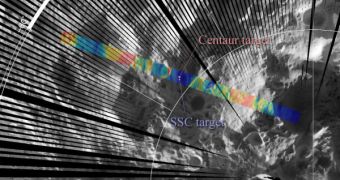The Lunar CRater Observation and Sensing Satellite (LCROSS) mission that slammed into the Moon exactly one week ago may have been destined to fail since its early days, some scientists are beginning to believe. The mission is not a failure in itself, but critics say that it was a mistake to expect that a huge plume of ice and dust would be thrown out ten miles into the air as the spent Centaurus rocket stage slammed into the surface of the Moon.
A number of computer simulations was used to calculate the angle and the velocity the rocket stage would need to be in so as to produce the best evidence. Some of these simulations, NASA officials admitted, might have been exaggerated, and some of them weren't even conducted at the space agency's research centers or laboratories. LCROSS Project Manager Dan Andrews says that some of the simulations that offered the foundation for the mission may have tainted all of its results.
When the Centaurus rocket stage crashed into the Cabeus crater, at the south pole of the Moon, last Friday, it did not generate the debris plume everyone expected it to. As a result, when the LCROSS probe swirled past, heading towards its own impact site, it could not photograph the debris. It only captured a fleeting infrared reading of the Centaurus crash site, just moments before it crashed, a few kilometers away from the rocket's impact site.
Some experts also say that the depth of the Cabeus crater may have been underestimated, which would explain why so little debris was visible to the approaching LCROSS. Brown University expert Peter Schultz, an LCROSS team member, said that the projectile tests he and his team had performed at NASA a while back had shown that the debris would not be spewed at a 45-degree angle, as the LCROSS experts thought, but at an angle closer to 30 degrees. “That's not going to see sunlight,” he told NewScientist.
“LCROSS was not a sound strategy to pursue if your objective was to answer the question, is there water ice on the moon? And if so, where is it and what is its state?” Lunar and Planetary Institute expert Paul Spudis concludes from Houston, Texas.

 14 DAY TRIAL //
14 DAY TRIAL //